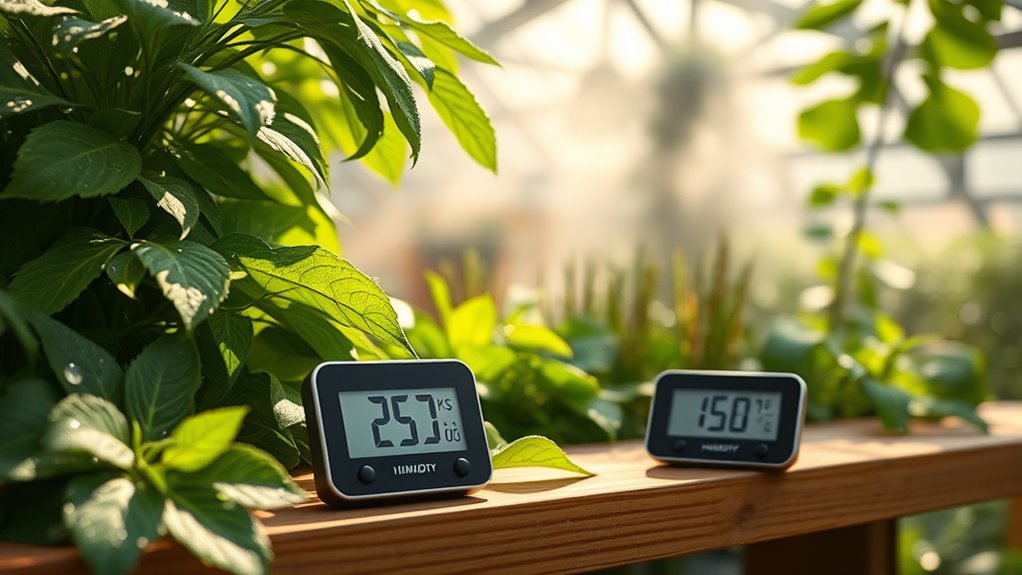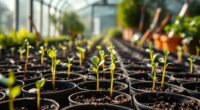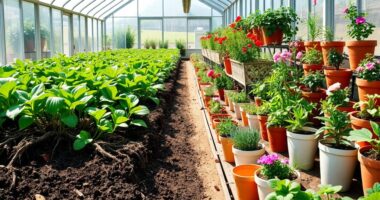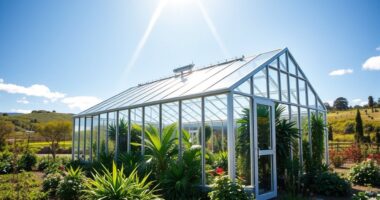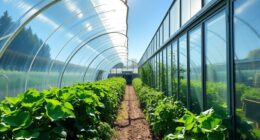To keep your greenhouse climate just right, you need to balance temperature and humidity carefully. Too hot or humid can boost pests and disease, while too cold or dry can stress plants. Use sensors and automated systems to monitor conditions in real-time. Adjust heating, cooling, humidifiers, or dehumidifiers as needed to maintain ideal levels for your plants. You’ll discover simple strategies to create a thriving environment if you continue exploring these basics.
Key Takeaways
- Maintain optimal temperature and humidity levels tailored to specific plants to promote healthy growth.
- Use real-time sensors and climate control systems to monitor and adjust environmental conditions promptly.
- Balance humidity to prevent soil from drying out or becoming overly moist, reducing pest and disease risks.
- Manage temperature and humidity interactions to create a stable environment that supports plant vitality.
- Regularly assess and fine-tune greenhouse conditions based on plant needs and environmental feedback.

Have you ever wondered how temperature and humidity affect your daily environment? When you’re managing a greenhouse, these factors are essential for creating the ideal growing conditions. They influence everything from plant health to pest control, and understanding their impact helps you maintain a stable, thriving environment. Temperature controls the rate of plant growth, nutrient uptake, and overall vitality, while humidity affects how plants transpire and how pests and diseases spread. Maintaining the right balance means paying attention not just to these elements individually but also to how they interact.
Balancing temperature and humidity is key to healthy, thriving greenhouse environments.
One key aspect often overlooked is soil moisture, which is directly affected by humidity levels. When humidity is too low, soil tends to dry out quickly, requiring frequent watering. Conversely, high humidity can lead to overly moist soil, promoting root diseases and mold. Striking the right balance ensures plants have consistent access to water without risking over-saturation. Proper soil moisture management also plays a critical role in pest control. Many pests thrive in damp, humid conditions, so by controlling humidity levels, you can reduce their proliferation. For example, keeping humidity slightly lower during certain times can discourage pests like fungus gnats and mold mites, which prefer moist environments. Regular monitoring and adjusting humidity levels accordingly help you prevent pest outbreaks before they become problematic.
Temperature and humidity also influence pest behavior and plant susceptibility. High temperatures combined with high humidity create an ideal environment for certain pests and diseases, making pest control more challenging. On the other hand, cooler, drier conditions can suppress pest activity but might stress your plants. It’s essential to find that sweet spot where pests are less active, and your plants remain healthy. Ventilation, heating, and humidifiers or dehumidifiers are your main tools here. Properly managing these elements allows you to create a resilient environment where pests are kept in check naturally, reducing the need for chemical interventions. Additionally, AI-powered sensors and analytics can help optimize climate conditions more precisely, leveraging AI in greenhouse management to improve outcomes.
Ultimately, balancing temperature and humidity requires continuous monitoring and adjustments. Use reliable sensors to track changes in real-time and respond quickly to fluctuations. Incorporating advanced climate control systems can further enhance your ability to maintain optimal conditions consistently. By doing so, you optimize soil moisture, promote healthy plant growth, and implement effective pest control measures. When you keep your greenhouse climate just right, you not only improve your plants’ health but also make pest management easier and more sustainable. It’s about creating a controlled environment where every element works in harmony, ensuring your plants thrive and your efforts pay off. Additionally, understanding the specific climate requirements of different plant species can help tailor your environment even more precisely. Knowledge of climate control systems and their capabilities can further refine your approach for optimal results. Moreover, integrating mindfulness in environmental management can help you stay attentive to subtle changes, ensuring your greenhouse remains a balanced and healthy space.
Frequently Asked Questions
How Does Airflow Impact Greenhouse Temperature and Humidity?
Airflow impacts your greenhouse’s temperature and humidity by moving air through the space, preventing hot spots and excess moisture. Proper airflow patterns created by your ventilation systems help distribute heat evenly and reduce humidity levels, which minimizes mold and pests. When you optimize ventilation, you guarantee fresh air circulation, keeping your plants healthy. Regularly check and adjust your airflow patterns to maintain an ideal climate inside your greenhouse.
What Are the Effects of Extreme Temperature Fluctuations on Plants?
Did you know that rapid temperature swings can cause significant plant stress? When temperatures fluctuate drastically, your plants may struggle with growth disruption and become more vulnerable to diseases. Extreme changes can damage cell structures and impair nutrient uptake, making it harder for your plants to thrive. To prevent this, maintain stable conditions, and avoid sudden heat or cold shocks that could jeopardize your greenhouse’s productivity.
How Often Should I Calibrate My Humidity and Temperature Sensors?
You should calibrate your humidity and temperature sensors regularly to guarantee sensor accuracy. Typically, perform calibration every 3 to 6 months, but if you notice inconsistent readings or drastic climate changes, do it more often. Proper calibration maintains reliable data, helping you optimize your greenhouse environment. Consistent calibration reduces errors and prevents plant stress caused by inaccurate temperature and humidity readings.
Can Natural Ventilation Alone Maintain Optimal Climate Conditions?
Sure, relying solely on natural ventilation might seem like a breeze, but it’s often more of an uphill climb. Passive cooling helps, yet it can’t always adapt quickly to sudden temperature swings or humidity spikes. While natural ventilation can help maintain a decent climate, you’ll likely need supplemental methods to keep things just right. So, don’t forget—sometimes, a little mechanical help is your best friend in greenhouse management.
What Are the Signs of Improper Humidity Levels in Plants?
When your plants show signs of improper humidity levels, you’ll notice issues like leaf curling, which indicates stress from too little moisture or excessive dryness. Overwatering often leads to soggy soil and root rot, while inadequate humidity can cause leaves to become brittle or curl inward. Keep an eye on these signs to adjust your watering and ventilation practices, ensuring your plants stay healthy and thriving.
Conclusion
By mastering temperature and humidity, you’re the captain steering your greenhouse’s climate ship through calm and stormy seas alike. When you keep these factors balanced, your plants will flourish like a well-tuned orchestra, each note perfectly in harmony. Remember, a stable environment is the root of healthy growth. So, stay vigilant and adjust as needed—your green oasis depends on it. With the right climate, you’re planting the seeds for a lush, thriving garden that blooms endlessly.
